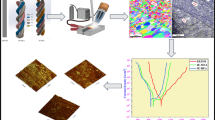Abstract
Residual stresses are often the cause for cracks in weld constructions. That is why the residual stress level, induced by manufacturing process, plays a crucial role. The present study aims on the effect of multiple repair weld procedures on a high-strength structural steel S690QL. The widespread technology of carbon arc-air gouging was applied. The weld zone and the heat-affected zone (HAZ) were subjected to multiple thermal cycles by gouging and subsequent repair welding. The investigations were focused on the change of the residuals stresses, the impact on the microstructure and the changes for the mechanical properties of the repair welded joint. The residual stresses were determined by X-ray diffraction. The results have shown a significant dependence for the residual stress levels from the repair cycle. In addition, distinctive changes in microstructures and hence mechanical properties occurred. The fusion line of the repair weld and the adjacent HAZ are the most critical areas. This is where the loss of ductility is most pronounced.

















Similar content being viewed by others
References
Siewert Th, Samardzic I (2002) Reliability improvements in repair welding of high-strength Steels IIW Doc IX-2002-01
Smith GC (1978) Holz, P.P.: Repair weld induced residual stresses in thick-wall pressure vessels. NUREG/CR-0093
Canonico DA, Whitman GD Evaluations of half-bead weld repair procedures with thick-wall pressure vessels Internet-Publication 1978; http://www.osti.gov/
Thermadyne arc-air carbon guide March 2006, www.thermadyne.com
Miltyutin VS The effect of arc-air cutting on the quality of metal Welding Production 26 1979, No. 10, pp. 44–46
Doshchechkina et al. Changes in the structure of the surface zone in the air-cutting of metals Welding Production 27 1980, No. 5, pp. 40–42
Babu SS, Goodwin GM, Rohde RJ, Sielen B (1998) Effect of boron on the microstructure of low-carbon steel resistance seam welds. Weld J 77:249–253
Liu C et al (2002) Mechanical properties of heat affected zone in bainitic high strength low alloy steel. Mater Sci Technol 18(11):1325–1328
Zhang XZ, Knott JF (1999) Cleavage fracture in bainitic and martensitic microstructures. Acta Mater 47(12):3483–3495
Satoh K, Ueda Y, Kihara H (1972) Recent trend of researches on restrain stresses and strains for weld cracking. Trans JWRI 1(1):53–68
Satoh K (1972) An analytical approach to the problem of restraint intensity in slit weld. Trans JWRI 1(1):69–76
Schwenk C, Kannengiesser Th, Rethmeier M (2009) Restraint conditions and welding residual stresses in self-restrained cold cracking test. Trends in welding research. Proceedings of the 8th international conference, pp. 766–773
Böllinghaus T, Kannengießer T, Neuhaus M (2005) Effects of the structural restraint intensity on the stress strain build up in butt joints. Math Model Weld Phenom 7. ISBN 3-901351-99-X, pp. 651–669
Ueda Y, Takahashi E, Fukuda K, Nakacho K (1974) Transient and residual stresses in multi-pass-welds. Trans JWRI 3(1):59–67
Ueda Y, Fukuda K, Kim YC (1982) Analytical calculation method of restrain stresses and strains due to slit weld in rectangular plates. Trans JWRI 11(1):105–113
Ueda Y, Fukuda K, Kim YC, Koki R (1982) Characteristics of restraint stress-strain of slit weld in a finite rectangular plate and the significance of restraint intensities as a dynamical measure. Trans JWRI 11(2):105–113
Ueda Y, Fukuda K, Nishimura I, Iiyama H, Chiba N (1984) Cracking in welded corner joints. Metal Construction and British Welding Journal, pp. 30–34
Böllinghaus T, Hoffmeister H, Ruyter E (1997) Calculations of restraint intensities by finite element analysis for the assessment of weldability. Math Model Weld Phenom 3:606–623
Böllinghaus T, Hoffmeister H, Schwager A (1997) Calculations of restraint intensities at large offshore steel structures by finite element analysis. Math Model Weld Phenom 3:624–651
Stout RD et al (1976) A field weldability test for pipeline steels. Weld J 55(4):89–94
Vasudevan R et al (1980) A field weldability test for pipeline steels - part II. Weld J 59(3):76–84
Vasudevan R et al (1981) Hydrogen assisted cracking in HSLA pipeline steels. Weld J 60(9):155–168
Author information
Authors and Affiliations
Corresponding author
Additional information
Doc. IIW-2570, recommended for publication by Commission II "Arc Welding and Filler Metals"
Rights and permissions
About this article
Cite this article
Schasse, R., Kannengiesser, T., Kromm, A. et al. Residual stresses in repair welds of high-strength low-alloy steels. Weld World 59, 757–765 (2015). https://doi.org/10.1007/s40194-015-0257-9
Received:
Accepted:
Published:
Issue Date:
DOI: https://doi.org/10.1007/s40194-015-0257-9




